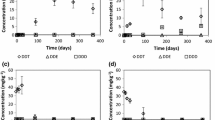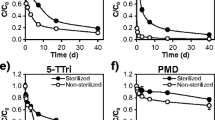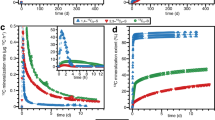Abstract
Dicyclopentadiene (DCPD) is formed during the pyrolysis of alkanes to produce olefins suitable for manufacturing synthetic polymers. DCPD has an irritating odor with a 5 ppb detection level that provides the impetus for remediation efforts. One method of destroying odors is to alter the structure of the chemical. This can be accomplished by biological oxidation using microorganisms. Field studies at two sites, where DCPD was a soil contaminant, indicated that biodegradation contributed significantly to DCPD removal. DCPD degradation was stimulated by decreasing bulk soil density and adding nitrogen and phosphorous nutrients. The presence of other easier degradable aromatic hydrocarbons may also be beneficial, suggesting that the process is cometabolic.
Similar content being viewed by others
References
Amoore JE & Hautala E (1983) Odor as an aid to chemical safety: Odor thresholds compared with threshold limit values and volatilities for 214 industrial chemicals in air and water dilution. J. Appl. Toxicol. 3: 272–290
Barbaro JR, Barker JF, Lemon LA & Mayfield CI (1992) Biotransformation of BTEX under anaerobic denitrifying conditions: Field and laboratory observations. J Contam Hydrol 11: 245–272
Barker JF, Patrick GC & Major D (1987) Natural attenuation of aromatic hydrocarbons in a shallow sand aquifer. Water Monitor Rev, Winter Issue: 64–71
Dupont RR, Sorensen DL & Kemblowski M (1994) Evaluation of intrinsic bioremediation at an underground storage tank site in northern Utah. In: Proceedings of the EPA Symposium on Intrinsic Bioremediation of Ground Water, pp. 176–177. U. S. Environmental Protection Agency, Washington, DC
Environment Canada (1992) Biological Test Method: Toxicity Test Using Luminescent Bacteria (Vibrio fischeri). EPS 1/RM/24. Section 7, Specific Procedures for Testing Samples of Effluent, Leachate, and Elutriate. Ottawa, Ontario
EPA (1986a) Method 3810: Headspace. In: Test Methods for Evaluating Solid Waste. Volume 1B: Laboratory Manual Physical/Chemical Methods, Third Edition. United States Environmental Protection Agency, Office of Solid Waste and Emergency Response, SW 846, Washington, DC, Revised September, 1986, pp. 3810–1–3810–5
EPA (1986b) Method 8260: Volatile organic compounds by gas chromatography/mass spectrometry (GC/MS): Capillary column technique. In Test Methods for Evaluating Solid Waste. Volume 1B: Laboratory Manual Physical/Chemical Methods, 3rd Edn. United States Environmental Protection Agency, Office of Solid Waste and Emergency Response, SW 846, Washington, DC, Revised November, 1990, pp. 8260–1–8260–51
NIOSH. 1972. National Institute of Occupational Safety and Health, Physical and Chemical Analysis Branch Analytical Method 127, Organic Solvents in Air, Revised 1977
Rodina AG (1972) Methods in Aquatic Microbiology. University Park Press, Baltimore, MD, p. 179
Schefler WC (1979) Statistics for the Biological Sciences, 2nd Edn. Addison-Wesley Publishing Company, Don Mills, Ontario, p. 227
Shen Y, Stehmeier LG & Voordouw G (1998) Identification of hydrocarbon-degrading bacteria in soil by reverse sample genome probing. Appl. Environ. Microbiol. 64: 637–645
Song HG (1988) Petroleum hydrocarbons in soil: biodegradation and effects on the microbial community. PhD thesis, Rutgers, The State University of New Jersey, New Brunswick
Spanggord RJ, Chou TW & Mabey WR (1979) Studies of Environmental fates of DIMP and DCPD. Supported by the US Army Medical Research and Development Command, Fort Detrick, Frederick, MD. 21710. Contract No. DAMD 17–78-C-8053. SRI Project LSU-7551. SRI International Report AD-AO78 236/7. SRI International, Menlo Park, CA 94025
Stahl WF (1995) Cyclopentadiene/Dicyclopentadiene-United States. Chemical Economics Handbook-SRI International. 640.5000 A
Stehmeier LG, Jack TR & Voordouw G (1996) In vitro biodegradation of dicyclopentadiene by microbial consortia isolated from hydrocarbon contaminated soil. Can. J. Microbiol. 42: 1051–1060
Thierrin J, Davis GB, Barber C, Patterson BM, Pribac F, Power TR & Lambert M (1993) Natural degradation rates of BTEX compounds and naphthalene in a sulfate reducing groundwater environment. Hydrol. Sci. J. 38(4): 309–322
Van Breemen RB, Fenselau CC, Cotter RJ, Curtis AJ & Connolly G (1987) Derivatives of dicyclopentadiene in ground water. Biomed. Environ. Mass Spectrom. 14: 97–102
Van Breemen RB, Tsou Y & Connolly G (1993) Oxidation of dicyclopentadiene in surface water. Biol. Mass Spectrom. 22: 579–584
Ventura F, Romero J & Pares J (1997) Determination of dicyclopentadiene and its derivatives as components causing odors in groundwater supplies. Environ. Sci. Technol. 31: 2368–2374
Verschueren K (1983) Handbook of environmental data on organic chemicals. 2nd ed. Van Nostrand Reinhold Co., New York
Rights and permissions
About this article
Cite this article
Stehmeier, L.G., Francis, M.M., Jack, T.R. et al. Biodegradation of dicyclopentadiene in the field. Biodegradation 10, 135–148 (1999). https://doi.org/10.1023/A:1008301631122
Issue Date:
DOI: https://doi.org/10.1023/A:1008301631122




